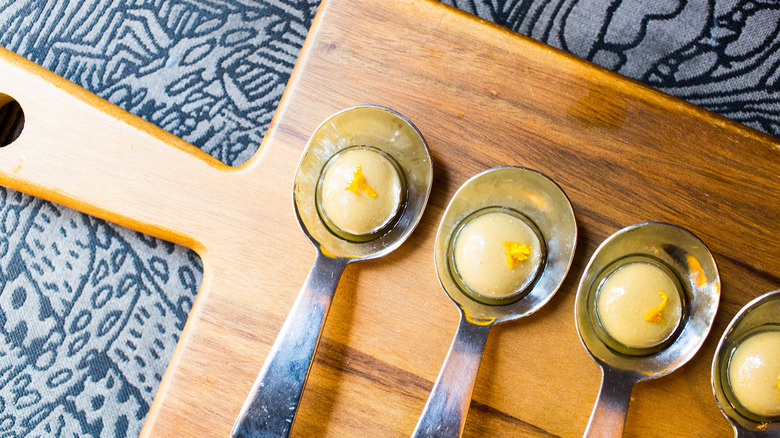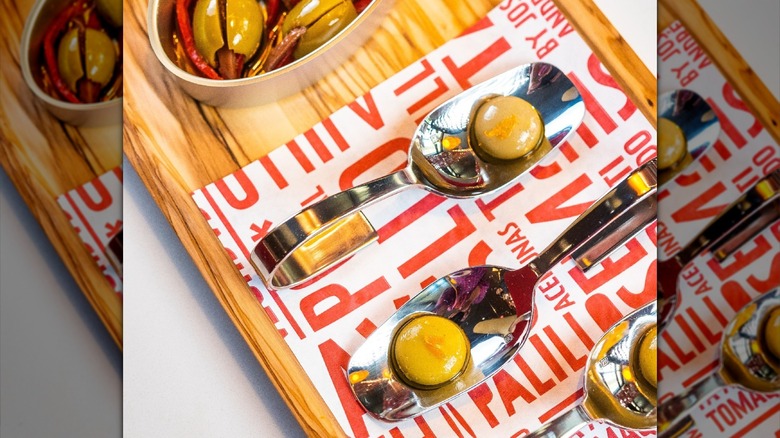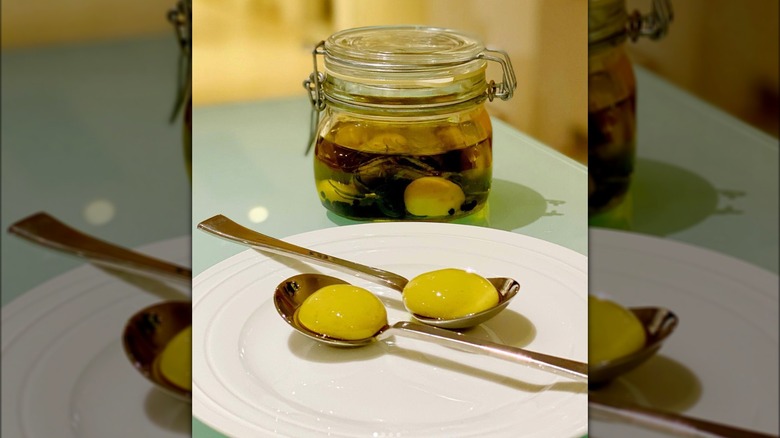Liquid Olives Blur The Line Between Tapas And Science Project
We may receive a commission on purchases made from links.
Olives are a classic accouterment for cocktails and charcuterie boards; they're simple seeming enough, but when you turn them into a liquid olive, now that's something both new and familiar. In case you are unfamiliar, liquid olives are kind of what they sound like; an olive is pureed, coated in olive oil, and held together with a thin gel layer, creating a small sphere of olive puree that bursts open when you bite into it. Chef José Andrés serves them at some of his tapas restaurants since he enjoys serving traditional ingredients using modern techniques. Andrés says on the website for his restaurant The Bazaar, "When you introduce the olives in your mouth, it's going to explode. Your mouth is going to be full of flavors."
Andrés serves liquid olives in honor of his mentor Spanish chef Ferran Adrià who likely invented liquid olives, but at the very least pioneered the technique used to make them. Today, you'll find a variety of tapas restaurants that, like Andrés, serve liquid olives due to Adrià's influence. The dish is a fascinating introduction to a process known as reverse spherification, which is also used to make some popping boba bubbles. Only in this case, the ingredients are green olive juice and a couple of other specialized ingredients that facilitate the reverse specification process.
Reverse spherification and its sibling spherification are techniques that chefs sometimes use to create new textures out of familiar ingredients. Spherification is used to make a liquid ingredient into a semi-solid sphere-like shape, while reverse spherification creates a similar sphere with a center that stays liquid longer, according to Penn College. While the technique draws from scientific techniques, it is something people can try in their own home kitchens.
How liquid olives are made
Using lab-like techniques, chefs like Adrià' and Andrés break down, liquefy, and reform the olive. While the reverse spherification process draws upon chemistry, you probably have everything you need in your kitchen except for ingredients like sodium alginate and sodium gluconate or calcium lactate gluconate which are used to enhance or stabilize texture in food and medicine — though even these can be bought online from specialty food manufacturer's.
To make liquid olives, chefs start with uncured green olives, pit them, and puree them. After straining the olive puree, they mix it with a neutral salt like sodium gluconate. Spoonfuls of the mixture are dropped into and submerged in a bath of water and sodium alginate, which is a food stabilizer extracted from brown seaweed. Spheres of olive puree form from the reaction between the sodium alginate and gluconate. This reaction creates a thin, tasteless gel membrane that holds the liquid sphere together. Reverse Spherification works best for ingredients that naturally contain calcium, and while you may not think of olives as a source of calcium, each one contains about 2 milligrams. Finally, the olive spheres are usually coated in a thin layer of olive oil and served on tasting spoons. Chef Ferran Adrià used an herb-infused olive oil as his finishing touch, but plain olive oil also works.
Liquid olives were among some of the first dishes Chef Adrià first created using reverse spherification, but many other dishes rely on the same technique like juice cavaliers, popping boba, or even spherificated cocktails.
It's all molecular gastronomy to me
Reverse spherification is a technique associated with the broader discipline of molecular gastronomy, an area of scientific study and a culinary movement that explores the physical and chemical changes in food's texture, appearance, and flavor. In an interview with LinkedIn, Marcel Vigneron, a Top Chef alum who previously studied with Chef Ferran Adrià, said, "Molecular gastronomy can be the collaboration of chef and scientist. Just basically understanding the phenomenon that is cooking." Ultimately, by combining their scientific knowledge and culinary expertise, chefs can create entirely new dishes like liquid olives.
Of course, cooks have always experimented with and observed the transformative power of cooking, but the term "molecular gastronomy" and the field of study was first established in 1988 by scientists at the University of Oxford, per Britannica. By the 90s, chefs were playing with molecular gastronomy in their kitchens, using liquid nitrogen to flash-freeze sorbet, making foam curry sauces, and experimenting with sous vide preparation methods. Thus a new culinary movement and cooking style — molecular cuisine — was born.
Chefs like Ferran Adrià as well as his disciples used spherification and reverse spherification to create liquid olives. Another pioneer of the culinary movement British chef Heston Blumenthal is known for pioneering the use of liquid nitrogen in restaurants, using it to create a nitro-poached mousse palate cleanser and tableside ice cream. Over time, these techniques have become surprisingly mainstream; while you may not find liquid olives everywhere, you can find nitrogen gas-infused cold brew coffee and sous vide egg bites at your local coffee shop or may even make them at home.


